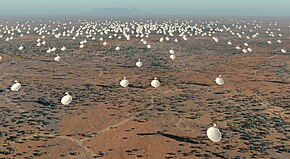30°43′16″S 21°24′40″E / 30.72111°S 21.41111°E
 Artist's impression | |
| Alternative names | SKA |
|---|---|
| Named after | square kilometre, antenna array |
| Location(s) | Meerkat National Park, South Africa and Murchison Radio-astronomy Observatory, Australia |
| Coordinates | 30°43′16″S 21°24′40″E / 30.72111°S 21.41111°E and 26°41′49.3″S 116°37′52.6″E / 26.697028°S 116.631278°E |
| Built | 2018–2024 |
| First light | 2027 (projected) |
| Telescope style | phased array |
| Collecting area | 1 km2 (11,000,000 sq ft) |
| Website | www |
| | |
The Square Kilometre Array (SKA) is an intergovernmental international radio telescope project being built in Australia (low-frequency) and South Africa (mid-frequency). The combining infrastructure, the Square Kilometre Array Observatory (SKAO), and headquarters, are located at the Jodrell Bank Observatory in the United Kingdom. The SKA cores are being built in the southern hemisphere, where the view of the Milky Way galaxy is the best and radio interference is at its least.
Conceived in the 1990s, and further developed and designed by the late-2010s, when completed sometime in the 2020s it will have a total collecting area of approximately one square kilometre. It will operate over a wide range of frequencies and its size will make it 50 times more sensitive than any other radio instrument. If built as planned, it should be able to survey the sky more than ten thousand times faster than before. With receiving stations extending out to a distance of at least 3,000 km (1,900 mi) from a concentrated central core, it will exploit radio astronomy's ability to provide the highest-resolution images in all astronomy.
The SKAO consortium was founded in Rome in March 2019 by seven initial member countries, with several others subsequently joining; as of 2021[update] there were 14 members of the consortium. This international organisation is tasked with building and operating the facility. The project has two phases of construction: the current SKA1, commonly just called SKA, and a possible later significantly enlarged phase sometimes called SKA2. The construction phase of the project began on 5 December 2022 in both South Africa and Australia.